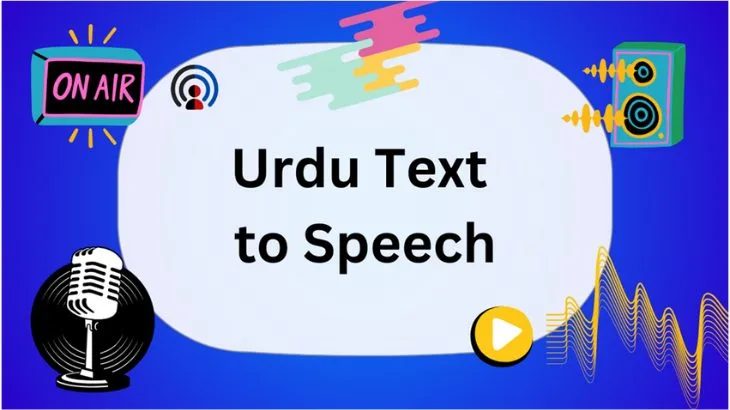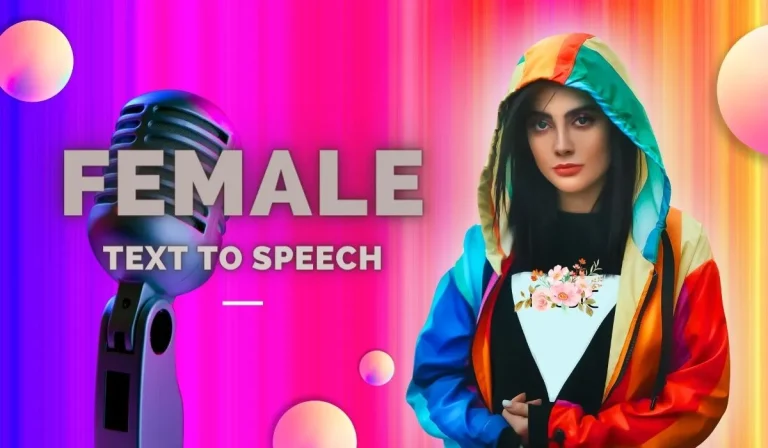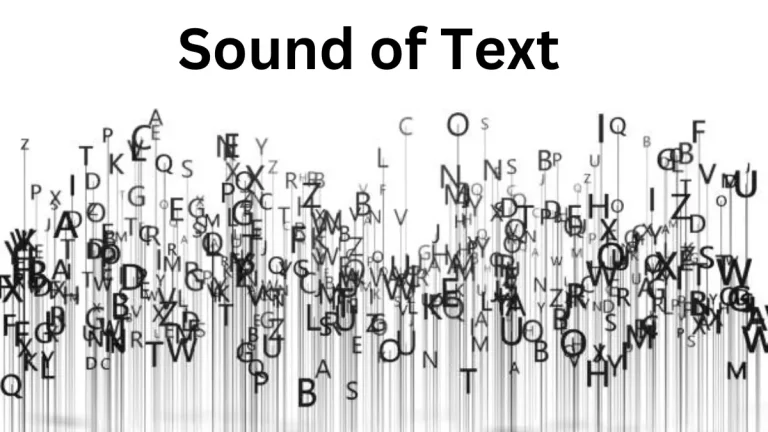Urdu Text to Speech
Urdu Text to Speech (TTS) is a cutting-edge technology that brings written Urdu text to life through synthetic speech. This innovative field has gained significant momentum in recent years, revolutionizing the way we interact with text in the Urdu language.
It has opened doors to a wide range of applications, from enhancing accessibility for visually impaired individuals to enabling more immersive language learning experiences. In this introduction, we’ll delve into the fascinating world of Urdu TTS, exploring its development, applications, and the impact it has on various aspects of our lives.
How to convert Urdu text to speech (Pakistan) accent
Converting urdu text to speech in a specific accent, such as the Urdu accent from Pakistan, typically involves using Text-to-Speech (TTS) synthesis systems that support the accent or dialect you desire. Here are the steps to convert text to speech in a Pakistani Urdu accent:
1. Choose a TTS System:
Start by selecting a Text-to-Speech system that supports Urdu with a Pakistani accent. There are several TTS systems and APIs available that offer different accents and dialects. Google Text-to-Speech, Amazon Polly, Microsoft Azure Cognitive Services, and various open-source TTS models like Mozilla’s TTS are some options to consider.
2. Install and Configure:
If you are using an open-source TTS model, you may need to install it on your local machine or server. Configure the TTS system to use the Urdu (Pakistan) accent if it’s not the default.
3. Input Text:
Provide the Urdu text to speech that you want to convert into speech. Ensure that the text is correctly formatted and includes proper punctuation and pronunciation guides for more accurate results, especially if your text includes names or specific terms.
4. Specify the Accent:
Depending on the TTS system you’re using, you might need to specify the accent or dialect explicitly. For instance, with Google Text-to-Speech, you can set the voice to ‘ur-PK’ (Urdu Pakistan) to get the desired accent.
5. Generate the Audio:
Trigger the TTS system to process the text and generate the audio output. This might be done through a command-line interface, API request, or a user-friendly web interface, depending on the TTS service you’ve chosen.
6. Listen and Review:
Once the audio is generated, listen to it to ensure it meets your expectations in terms of accent and pronunciation. You may need to fine-tune the input text or the TTS system’s settings if necessary.
7. Save or Stream:
You can choose to save the generated audio as a file for later use or stream it directly to your application or device.
8. Integrate into Your Application:
If you’re using TTS in a software application or website, integrate the TTS functionality as needed. Most TTS services provide documentation and code samples for easy integration into various platforms.
It’s important to note that the quality and naturalness of the accent can vary depending on the TTS system you choose. Therefore, it’s a good idea to test different systems and choose the one that best suits your needs for converting text to speech in a Pakistani Urdu accent.
Urdu voice over Online
If you’re looking for Urdu voice-over services online, there are various platforms and websites that connect you with professional voice actors who can provide voice-over recordings in the Urdu language. Here’s how you can find and utilize Urdu voice-over services online:
1. Online Voice-Over Marketplace
- Upwork: Upwork is a popular freelancing platform where you can find freelance voice-over artists. You can search for Urdu voice-over talent and review their profiles, ratings, and samples
- Fiverr: Fiverr is another platform where you can hire freelance voice-over artists. It allows you to browse through profiles,listen to samples, and choose the right voice for your project.
2. Dedicated Voice-Over Websites
Websites like Voices.com, Voice 123, and Voice Bunny specialize in connecting clients with professional voice actors. They have a search filter to help you find Urdu voice-over artists with the specific accent and tone you need.
3. Local Agencies
Consider contacting local advertising agencies, media production companies, or audio studios in Pakistan or regions with a significant Urdu-speaking population.They may have in-house or affiliated voice-over artists.
4. Social Media and Networking
You can also find voice-over artists on social media platforms like LinkedIn, where professionals often showcase their portfolios and connect with potential clients.
5. Project Details
Clearly define your project details, including the script, the desired tone (e.g., formal, casual, enthusiastic), any specific accent requirements (e.g., Pakistani Urdu), and the intended audience.
6. Script Delivery
Send the script to the voice actor, either through the platform you’re using or via email. Ensure that it is formatted correctly and includes any specific instructions.
Review and Feedback
After receiving the voice-over recording, review it carefully. If revisions are necessary, communicate your feedback to the artist for adjustments. Remember to choose a voice-over artist whose style and accent align with your project’s goals and target audience. Quality voice-over can greatly enhance the impact of your audio or video content, so take the time to find the right voice for your project.

Engage Your Audience with Authentic Urdu Voiceovers
Engaging an audience with authentic Urdu voiceovers is a powerful tool for creating immersive and impactful content. Urdu, with its rich cultural heritage and diverse linguistic nuances, comes to life when delivered through a native and authentic voice.
Whether it’s for marketing videos, documentaries, e-learning modules, or any other form of multimedia content, using Urdu voice overs helps establish a genuine connection with the audience. It not only ensures that the message is conveyed clearly and effectively but also adds an emotional depth that resonates with Urdu-speaking viewers.
Authenticity in voice overs fosters trust, captures attention, and makes the content more relatable, ultimately leaving a lasting impression on the audience. Whether your goal is to inform, inspire, or entertain, authentic Urdu voice overs can be a compelling means to achieve it.
Accessibility and Inclusivity for Urdu Content.
Accessibility and exclusivity are crucial principles when it comes to creating and disseminating Urdu content. By ensuring that content is accessible, we guarantee that it can be comprehended and engaged with by a diverse audience, including individuals with disabilities.
This means providing alternatives such as Urdu audio descriptions, closed captions, and transcripts for videos and multimedia content. In addition, this technology for Urdu content allows those with visual impairments to access written materials as synthesized speech, greatly enhancing their access to information and education.
Embracing these accessibility practices not only adheres to ethical standards but also broadens the reach and impact of Urdu content, making it more inclusive and beneficial to everyone, regardless of their abilities or disabilities. It’s a step toward creating a more equitable digital landscape where Urdu content is truly accessible to all.

Urdu Speech, download in MP3 or WAV Format
Downloading Urdu speech in MP3 or WAV format can be done through various sources and methods. Here’s a step-by-step guide to help you find and download Urdu speech in these formats:
Method 1: Online Speech Generators
Search Online: Use a search engine to find an online text-to-speech (TTS) generator that supports Urdu. For example, you can search for “Urdu text to speech online.”
- Choose a Tool: Select a TTS tool or website that offers Urdu speech generation. Some popular options include Google Text-to-Speech, iSpeech, or Natural Reader.
- Select Format: Many TTS generators allow you to choose the output format, such as MP3 or WAV. Select your preferred format.
- Generate Speech: Click the “Generate” or “Convert” button to initiate the speech synthesis process.
- Download: Once the speech is generated, you should see an option to download the generated speech in your chosen format (MP3 or WAV).Click the download link to save the file to your computer.
Method 2: Text-to-Speech Software
Download TTS Software: Install text-to-speech software on your computer or device that supports the Urdu language. Some popular TTS software includes Balabolka, Natural Reader, and NVDA (NonVisual Desktop Access).
- Select Output Format: In the software’s settings or options, choose the output format you prefer, such as MP3 or WAV.
- Generate Speech: Click the “Generate” or “Speak” button within the software to convert the text into speech.
- Save the Audio: After speech synthesis, you should have the option to save the generated audio as an MP3 or WAV file on your computer.
Method 3: Online Speech Repositories
Search for Speeches: You can also find pre-recorded Urdu speeches in MP3 or WAV format on online repositories, educational websites, or platforms like YouTube.
- Use YouTube: If you are looking for speeches on YouTube, you can use a YouTube video down loader tool to save the speech as an MP3 or WAV file. Simply paste the video URL into the down loader, select the desired format, and download the audio.
- Educational Websites: Some educational websites or e-learning platforms offer downloadable audio resources, including speeches in different languages, including Urdu.
- Online Libraries: Online libraries and archives may have audio recordings of speeches, lectures, or presentations in Urdu. Check if they offer download options in MP3 or WAV format. Ensure that you have the necessary rights and permissions to download and use the speech content, especially if it’s for commercial or public use.
- Always respect licensing agreements when downloading and using audio content from online sources.

Pros
- Efficiency: These systems can rapidly convert large volumes of text into speech, saving time and effort compared to manual narration.
- Consistency: TTS ensures consistent pronunciation, tone, and pacing, which can be crucial for maintaining a brand’s voice in audio content.
- Multilingual Support: Many TTS systems support multiple languages, making them versatile tools for global communication.
- 24/7 Availability: These systems can operate round the clock without fatigue, making them ideal for automated customer service and information hotlines.
- Scalability: TTS solutions can be easily scaled to meet the demands of growing content needs, making them suitable for various industries.
Cons
- Pronunciation Challenges:These systems may mispronounce or misinterpret certain words, names, or technical terms, requiring careful script editing.
- Lack of Contextual Understanding: These systems typically lack an understanding of the context in which the text is spoken, potentially leading to unnatural pauses or intonations.
- Emotional Nuance: Capturing emotional nuances and tone in speech remains a challenge for TTS systems, making them less suitable for content requiring empathetic or emotional delivery.
FAQs-Frequently Asked Questions
What are the applications of Urdu TTS?
Urdu TTS has various applications, including accessibility for the visually impaired, language learning, voice assistants, audio books, automated customer service, e-learning,and content localization.
Can Urdu TTS mimic different accents or dialects?
Some advanced Urdu text to speech TTS systems can mimic specific accents or dialects, but the capability varies depending on the system’s design. Users can often choose the desired accent or pronunciation style if the option is available.
Can I use Urdu text to speech TTS for commercial projects?
Yes, you can use Urdu TTS for commercial projects, but it’s important to review the licensing terms of this system you’re using to ensure compliance.Some TTS providers may have restrictions on commercial use.
Conclusion
In conclusion, Urdu Text to Speech (TTS) technology is a significant advancement in the realm of linguistics and artificial intelligence. It empowers individuals, businesses, and educational institutions to convert written Urdu text into lifelike speech, opening up a world of possibilities and opportunities.
However,it is not without its challenges, such as limitations in naturalness, accent variability, and the need for continuous improvement. While urdu text to speech it has made significant strides in producing human-like speech, there is room for further development to enhance emotional nuance and context understanding.
Also Read :
How to Make a Sound of Text Tone







